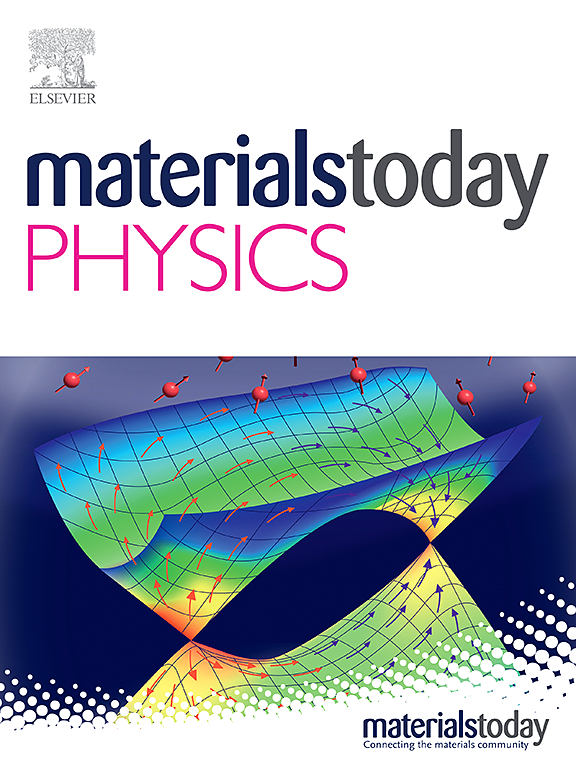Interlaced nanotwinned diamond and its deformation mechanism under pure shear strain
IF 10
2区 材料科学
Q1 MATERIALS SCIENCE, MULTIDISCIPLINARY
引用次数: 0
Abstract
While there is a relatively clear understanding of the deformation mechanisms of parallel nanotwinned diamonds with a single-orientated twin plane under shear strain from both experimental and theoretical studies, significant discrepancies remain between single-orientated parallel twins and experimentally observed twinned structures. These discrepancies hinder a comprehensive explanation of the structural evolution and deformation mechanisms in real twinned diamonds. To address this gap, we constructed an interlaced nanotwinned diamond structure with coexisting twins of different orientations and investigated its deformation mechanisms under pure shear strain. The interlaced twins with different orientations inevitably lead to the coexistence of sp3 bonds and sp2 line defects at the intersecting sites. Our findings reveal that under shear strain, the ideal twin interfaces in the interlaced nanotwinned diamond structure first undergo flip, transforming into a defective parallel nanotwinned diamond structure. As shear strain increases, this defective structure evolves into a unique diamond/graphite interface structure. Due to the strong local carbon bonds associated with sp2 defects, graphitization lags behind that of sp3 carbon bonds, leading to the formation of pentagonal ring structures at the interface. This imparts edge dislocation characteristics to the interface structure, which is significantly different from the diamond/graphite interfaces observed in high-temperature and high-pressure experiments on graphite. Calculations further indicate that continued increase in shear strain may lead to a series of transformations among diamond/graphite interface structures, defective diamond structures, and back to diamond/graphite interface structures. This study provides important insights into the deformation mechanisms of interlaced nanotwinned diamonds under extreme conditions and reveals a new type of diamond/graphite interface structure.
纯剪切应变下交错纳米孪晶金刚石及其变形机理
虽然通过实验和理论研究,人们对具有单方向孪晶平面的平行纳米孪晶金刚石在剪切应变下的变形机制有了相对清晰的认识,但单方向平行孪晶与实验观察到的孪晶结构之间仍存在显著差异。这些差异阻碍了对真实孪晶金刚石结构演变和变形机制的全面解释。为了弥补这一缺陷,我们构建了一种不同取向孪晶共存的交错纳米孪晶金刚石结构,并研究了其在纯剪切应变下的变形机制。不同取向的交错孪晶必然会导致交错位点上sp3键和sp2线缺陷的共存。我们的研究结果表明,在剪切应变作用下,交错纳米金刚石结构中的理想孪晶界面首先发生翻转,转变为有缺陷的平行纳米金刚石结构。随着剪切应变的增加,这种缺陷结构演变成独特的金刚石/石墨界面结构。由于与 sp2 缺陷相关的局部碳键很强,石墨化滞后于 sp3 碳键,导致在界面上形成五边形环结构。这使得界面结构具有边缘位错特征,与石墨高温高压实验中观察到的金刚石/石墨界面明显不同。计算进一步表明,剪切应变的持续增加可能会导致金刚石/石墨界面结构、缺陷金刚石结构和回归金刚石/石墨界面结构之间的一系列转变。这项研究为了解交错纳米绕丝金刚石在极端条件下的变形机制提供了重要见解,并揭示了一种新型的金刚石/石墨界面结构。
本文章由计算机程序翻译,如有差异,请以英文原文为准。
求助全文
约1分钟内获得全文
求助全文
来源期刊

Materials Today Physics
Materials Science-General Materials Science
CiteScore
14.00
自引率
7.80%
发文量
284
审稿时长
15 days
期刊介绍:
Materials Today Physics is a multi-disciplinary journal focused on the physics of materials, encompassing both the physical properties and materials synthesis. Operating at the interface of physics and materials science, this journal covers one of the largest and most dynamic fields within physical science. The forefront research in materials physics is driving advancements in new materials, uncovering new physics, and fostering novel applications at an unprecedented pace.
 求助内容:
求助内容: 应助结果提醒方式:
应助结果提醒方式:


